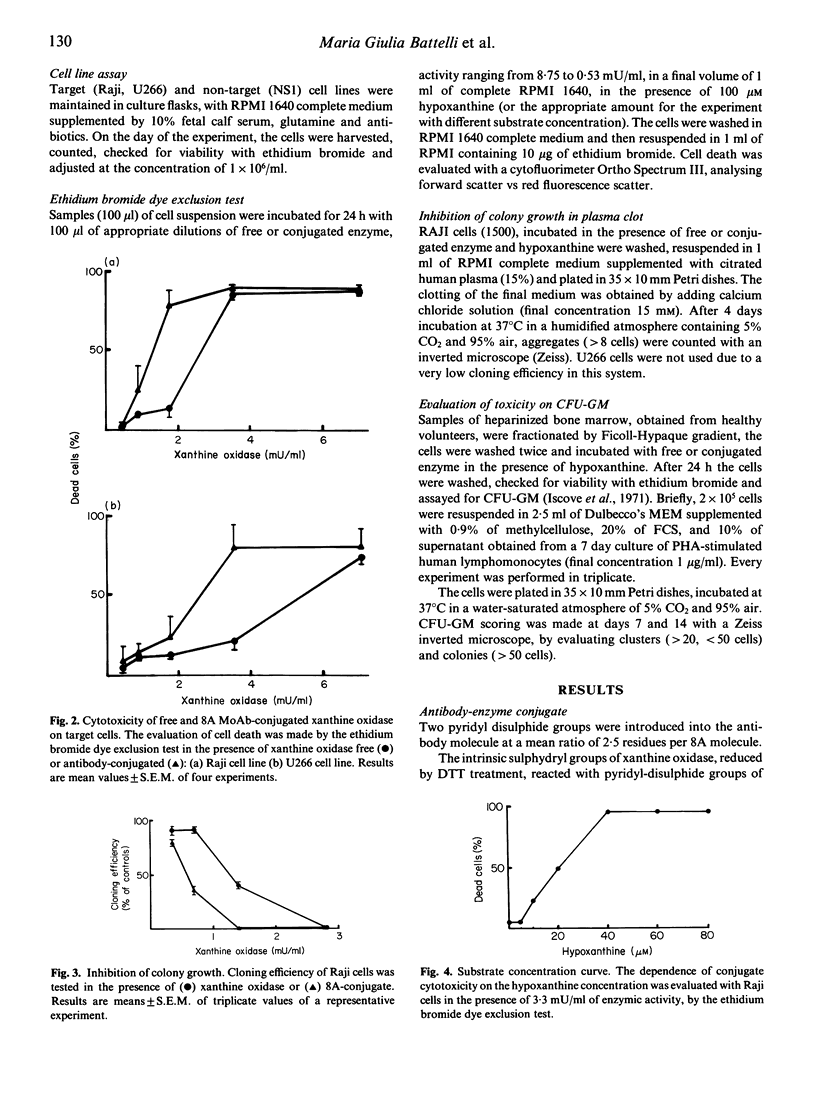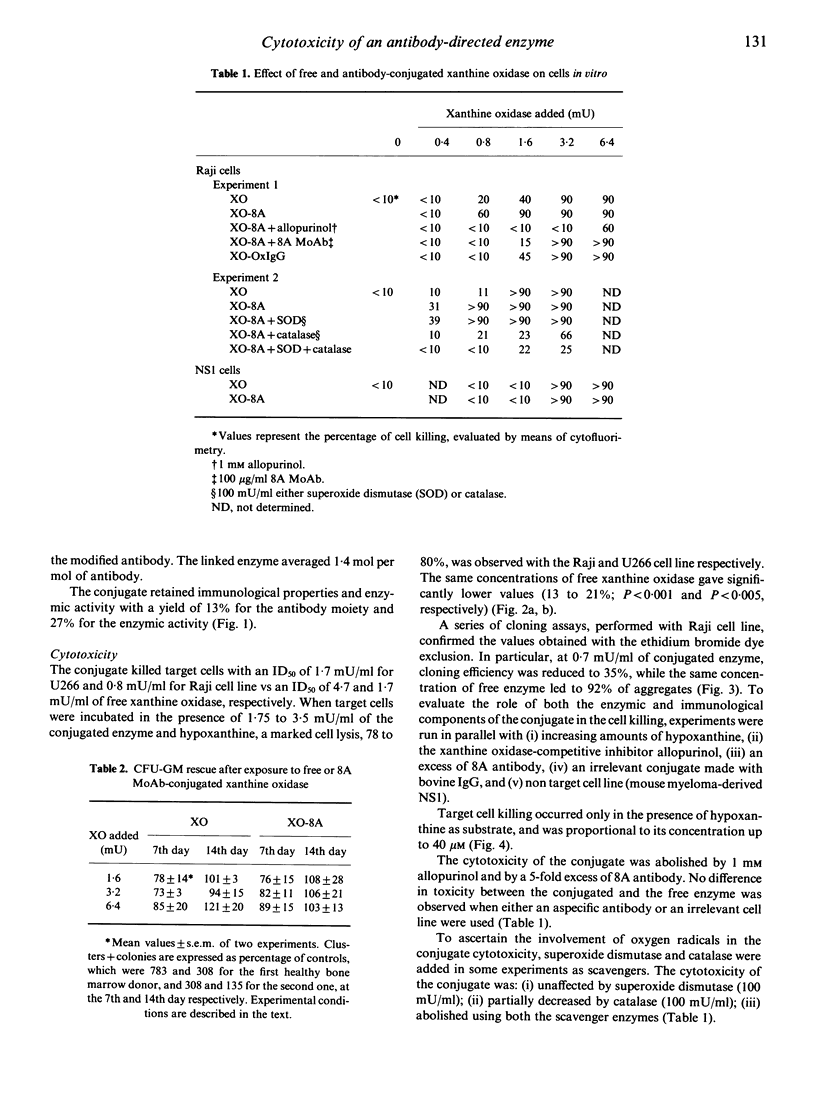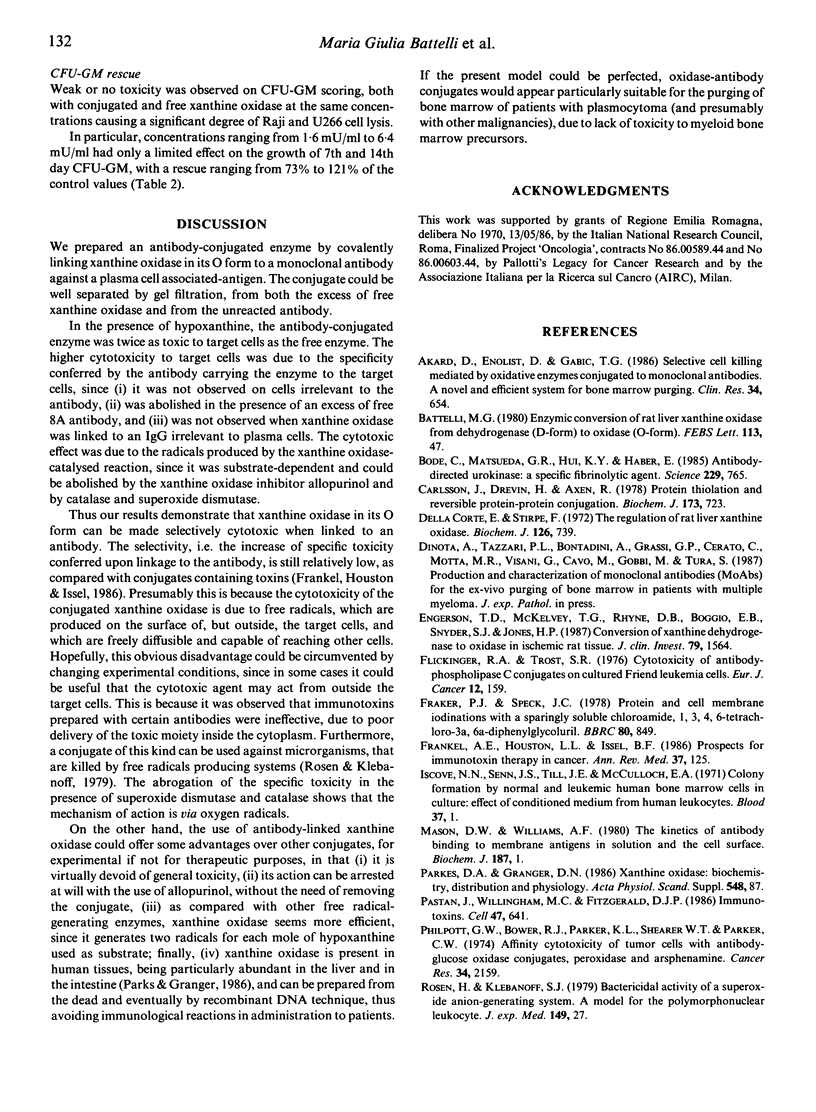Abstract
The monoclonal antibody 8A, which recognizes a human plasma cell-associated antigen, was covalently linked to xanthine oxidase in a conjugate maintaining both immunological and enzymatic properties. A significant degree of target cell lysis was obtained at an enzyme concentration that was ineffective on non-target cells and on myeloid staminal cells (CFU-GM). The cytotoxic activity was abolished by an excess of antibody, by allopurinol and by superoxide dismutase and catalase. A possible use of the conjugate for bone marrow purging in multiple myeloma patients is suggested.
Full text
PDF





Selected References
These references are in PubMed. This may not be the complete list of references from this article.
- Battelli M. G. Enzymic conversion of rat liver xanthine oxidase from dehydrogenase (D form) to oxidase (O form). FEBS Lett. 1980 Apr 21;113(1):47–51. doi: 10.1016/0014-5793(80)80491-1. [DOI] [PubMed] [Google Scholar]
- Bode C., Matsueda G. R., Hui K. Y., Haber E. Antibody-directed urokinase: a specific fibrinolytic agent. Science. 1985 Aug 23;229(4715):765–767. doi: 10.1126/science.4023710. [DOI] [PubMed] [Google Scholar]
- Carlsson J., Drevin H., Axén R. Protein thiolation and reversible protein-protein conjugation. N-Succinimidyl 3-(2-pyridyldithio)propionate, a new heterobifunctional reagent. Biochem J. 1978 Sep 1;173(3):723–737. doi: 10.1042/bj1730723. [DOI] [PMC free article] [PubMed] [Google Scholar]
- Corte E. D., Stirpe F. The regulation of rat liver xanthine oxidase. Involvement of thiol groups in the conversion of the enzyme activity from dehydrogenase (type D) into oxidase (type O) and purification of the enzyme. Biochem J. 1972 Feb;126(3):739–745. doi: 10.1042/bj1260739. [DOI] [PMC free article] [PubMed] [Google Scholar]
- Engerson T. D., McKelvey T. G., Rhyne D. B., Boggio E. B., Snyder S. J., Jones H. P. Conversion of xanthine dehydrogenase to oxidase in ischemic rat tissues. J Clin Invest. 1987 Jun;79(6):1564–1570. doi: 10.1172/JCI112990. [DOI] [PMC free article] [PubMed] [Google Scholar]
- Flickinger R. A., Trost S. R. Cytotoxicity of antibody-phospholipase C conjugates on cultured Friend leukemia cells. Eur J Cancer. 1976 Feb;12(2):159–160. doi: 10.1016/0014-2964(76)90220-6. [DOI] [PubMed] [Google Scholar]
- Fraker P. J., Speck J. C., Jr Protein and cell membrane iodinations with a sparingly soluble chloroamide, 1,3,4,6-tetrachloro-3a,6a-diphrenylglycoluril. Biochem Biophys Res Commun. 1978 Feb 28;80(4):849–857. doi: 10.1016/0006-291x(78)91322-0. [DOI] [PubMed] [Google Scholar]
- Frankel A. E., Houston L. L., Issell B. F., Fathman G. Prospects for immunotoxin therapy in cancer. Annu Rev Med. 1986;37:125–142. doi: 10.1146/annurev.me.37.020186.001013. [DOI] [PubMed] [Google Scholar]
- Mason D. W., Williams A. F. The kinetics of antibody binding to membrane antigens in solution and at the cell surface. Biochem J. 1980 Apr 1;187(1):1–20. doi: 10.1042/bj1870001. [DOI] [PMC free article] [PubMed] [Google Scholar]
- Parks D. A., Granger D. N. Xanthine oxidase: biochemistry, distribution and physiology. Acta Physiol Scand Suppl. 1986;548:87–99. [PubMed] [Google Scholar]
- Pastan I., Willingham M. C., FitzGerald D. J. Immunotoxins. Cell. 1986 Dec 5;47(5):641–648. doi: 10.1016/0092-8674(86)90506-4. [DOI] [PubMed] [Google Scholar]
- Philpott G. W., Bower R. J., Parker K. L., Shearer W. T., Parker C. W. Affinity cytotoxicity of tumor cells with antibody-glucose oxidase conjugates, peroxidase, and arsphenamine. Cancer Res. 1974 Sep;34(9):2159–2164. [PubMed] [Google Scholar]
- Rosen H., Klebanoff S. J. Bactericidal activity of a superoxide anion-generating system. A model for the polymorphonuclear leukocyte. J Exp Med. 1979 Jan 1;149(1):27–39. doi: 10.1084/jem.149.1.27. [DOI] [PMC free article] [PubMed] [Google Scholar]
- Stirpe F., Barbieri L. Ribosome-inactivating proteins up to date. FEBS Lett. 1986 Jan 20;195(1-2):1–8. doi: 10.1016/0014-5793(86)80118-1. [DOI] [PubMed] [Google Scholar]
- Stirpe F., Della Corte E. The regulation of rat liver xanthine oxidase. Conversion in vitro of the enzyme activity from dehydrogenase (type D) to oxidase (type O). J Biol Chem. 1969 Jul 25;244(14):3855–3863. [PubMed] [Google Scholar]
- Tazzari P. L., Gobbi M., Dinota A., Bontadini A., Grassi G., Cerato C., Cavo M., Pileri S., Caligaris-Cappio F., Tura S. Normal and neoplastic plasma cell membrane phenotype: studies with new monoclonal antibodies. Clin Exp Immunol. 1987 Oct;70(1):192–200. [PMC free article] [PubMed] [Google Scholar]


